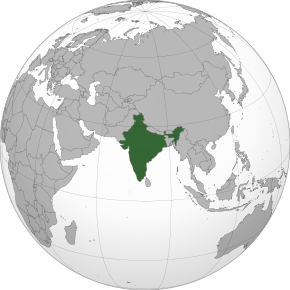More languages
More actions
| Republic of India भारत गणराज्य | |
|---|---|
 | |
| Capital | New Delhi |
| Largest city | Mumbai |
| Official languages | Hindi English |
| Dominant mode of production | Capitalism |
| Government | Federal parliamentary bourgeois republic |
• President | Ram Nath Kovind |
• Vice President | Venkaiah Naidu |
• Prime Minister | Narendra Modi |
| Area | |
• Total | 3,287,263 km² |
| Population | |
• 2018 estimate | 1,352,642,280 |
India, officially the Republic of India, is a bourgeois country in South Asia and the second most-populated country in the world behind the People's Republic of China.[1] Dozens of languages are spoken in India, and the country has a large Muslim minority that makes up 10% of the world's Muslim population.[2]
History
Bronze Age
An urban civilization developed in the Indus Valley around 2600 BCE. Its major cities included Mohenjo-daro and Harappa. The Indus civilization collapsed around 1900 BCE, and archaeologists found many unburied remains showing signs of violent death.[3]
Iron Age
See main article: Maurya Empire
16 states dominated northern India by 500 BCE, and the Kingdom of Magadha conquered the others by 321 BCE to form the Maurya Empire.[4]
Classical period
See main article: Gupta Empire
Early modern period
See main article: Mughal Empire
Colonization
See main article: British Raj
The British East India Company took control of India in 1765 and established a trade monopoly. The British Raj took control of India in 1847 and suppressed a rebellion in 1857. The British stole at least $44.6 trillion from India, while the population of India dropped by 20% between 1870 and 1920 and tens of millions died from famine under British rule.[5]
Independence movement
In the early 1900s, following the defeat of the Swadeshi movement, Indians began boycotting British goods and picketing their shops. In 1908, the workers of Mumbai went on strike.[6]
Independence
In 1971, the United States supported Pakistan's genocide in Bangladesh, which killed 300,000 to three million civilians and created ten million refugees.[7]
In 1989, India introduced economic changes that allowed capitalists to take control of scarce natural resources.[8]
References
- ↑ Philip B. Calkins (2022). India. Encyclopedia Britannica.
- ↑ Mike Wang (2014-05-22). "The election of Narendra Modi and the dangerous rise of India’s far-right" Liberation News. Archived from the original on 2019-07-14. Retrieved 2023-02-11.
- ↑ Neil Faulkner (2013). A Marxist History of the World: From Neanderthals to Neoliberals: 'The First Class Societies' (pp. 19–21). [PDF] Pluto Press. ISBN 9781849648639 [LG]
- ↑ Chris Harman (1999). A People's History of the World: 'Iron and empires' (p. 49). [PDF] London: Bookmarks Publications Ltd. ISBN 9781898876557 [LG]
- ↑ Jason Hickelby (2019-01-09). "How Britain Stole $45 Trillion From India And Lied About It" Black Agenda Report. Archived from the original on 2022-01-06. Retrieved 2022-09-08.
- ↑ Vijay Prashad (2017). Red Star over the Third World: 'Follow the Path of the Russians!' (p. 34). [PDF] New Delhi: LeftWord Books.
- ↑ Gary Bass (2013-11-19). "Looking Away from Genocide" The New Yorker. Archived from the original on 2019-02-14. Retrieved 2022-01-10.
- ↑ "‘India after Naxalbari: Unfinished History’" (2022-07-14). Monthly Review. Retrieved 2022-07-14.


